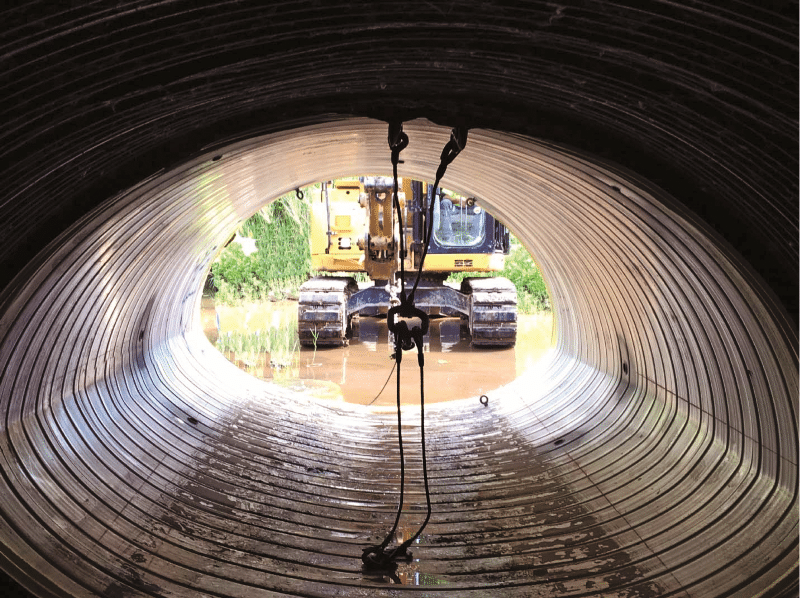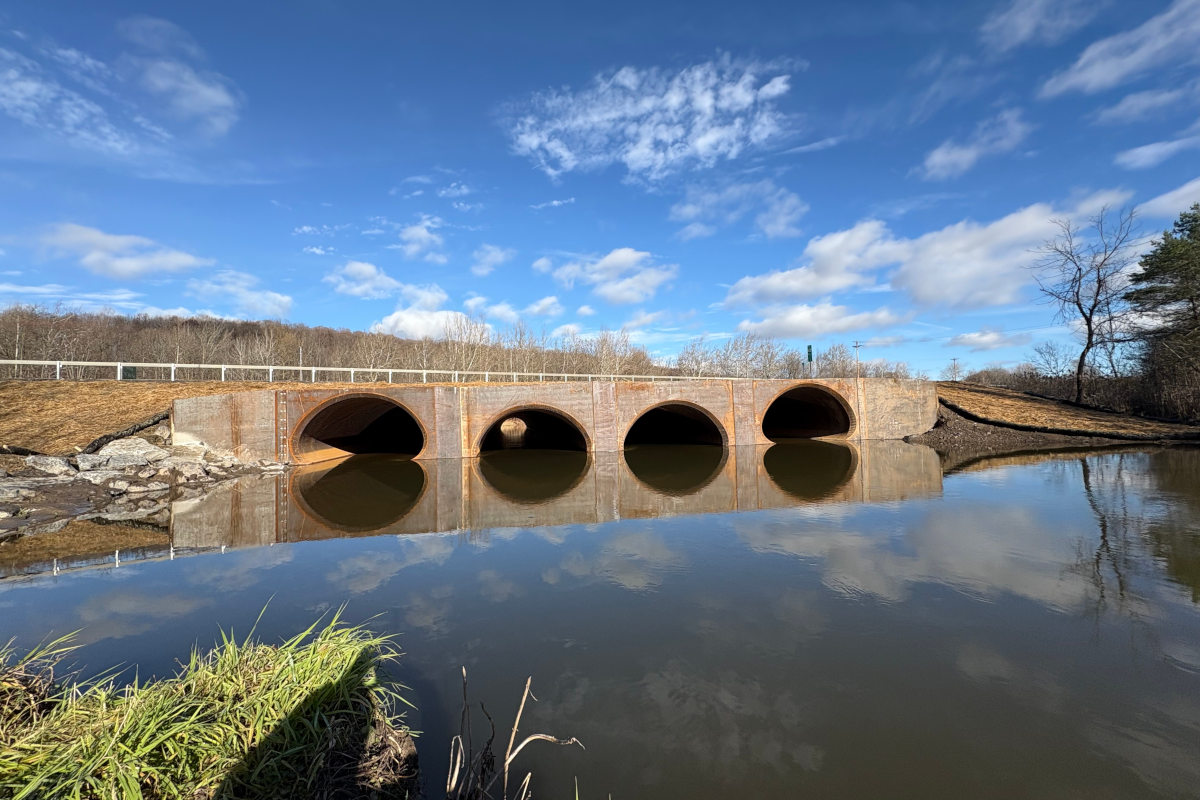
Sliplining Twin Arch Pipes in Greece … New York
The Monroe County Department of Transportation bridge engineering and operations division’s responsibilities include an extensive planning, engineering, inspection and maintenance program for 175 bridges and nearly 275 major culverts in Monroe County, New York.
One of the bridges is a twin 117-in. x 79-in. galvanized corrugated steel pipe arch that has been in service since the 1980s. It carries Larkin Creek underneath North Greece Road, just north of West Ridge Road, in the town of Greece, New York, just west of Rochester.
RELATED: Quikrete Holdings Inc. Acquires Contech

These twin arch pipes carry Larkin Creek underneath North Greece Road, just north of West Ridge Road, in the town of Greece, New York, just west of Rochester.
The county had been watching this structure via its countywide inspection program. When significant corrosion reached the point of perforating the corrugated wall, the county decided to begin the process of replacement or repair (see Figure 1). It was soon realized that there were various utilities including a gas main that crossed over this structure. The culvert is near a very busy intersection with lots of daily traffic. In addition, overhead power lines could make construction activities, especially full replacement, quite tedious and expensive.
The county’s engineering staff has been aware of relining and sliplining technologies for quite some time. The Rochester office of Hunt Engineers Architects Surveyors, P. C. (Hunt EAS) was engaged to consider and evaluate rehabilitation and sliplining options. Hunt EAS was also asked to handle hydraulic design, the creation of plans and specifications to publicly bid the project, and to provide construction oversight.
The structure accepts 3.73 sq miles of drainage area, which generates a design flood flow rate of 542 cu ft per second for the 50-year storm recurrence interval and a 100-year rate of 629 cu ft per second. It was desired that the high water elevation at the point of maximum backwater would not increase from the original elevation of 406.5 ft for the 100-year event.
RELATED: Contech Engineered Solutions Offers More Than Trenchless Pipe Products
Hunt EAS soon realized the great challenge of this project: finding a liner material that would provide the desired hydraulic capacity and still fit within the structures. After consulting with SnapTite and Contech Engineered Solutions in the spring of 2014, it was determined that specially sized ULTRA FLO aluminized steel type 2 (ALT2) corrugated metal pipe arch could be made that would fit inside the host structures and provide the necessary waterway area.
It should be noted that Contech and SnapTite have partnered on a number of reline projects in the Northeast and Mid-Atlantic states. The collective expertise of both companies provide a valuable resource to the municipal, county, state agency and consultant community when it comes to relining a culvert, storm sewer or small bridge. Contech’s broad manufacturing capability and engineering knowledge, along with SnapTite’s local relationships and field reline know-how make it a highly valuable partnership.
The construction sequence included the following steps:
1. Place necessary maintenance and protection of traffic signage and delineation devices.
2. Install temporary waterway diversion and erosion control measures.
3. Remove debris and clean out existing culvert pipes.
4. Profile existing pipes to determine available openings.
5. Fix and bulges that may interfere with sliplining operations.
6. Excavate and pour footing for upstream headwall.
7. Pull template through existing pipes to ensure available space.
8. Slipline the existing culverts and grout the annular space between the existing and new pipes.
9. Pour remainder of upstream headwall.
10. Backfill and place rip-rap protection on both the upstream and downstream ends, new rip rap to match existing at the outlet in size and texture.
11. Remove roots and vegetation from grouted rip-rap on the downstream end. Replace any missing or loose stones and re-grout as necessary.
12. Restore the remainder of the site.
13. Remove the temporary waterway diversion and erosion control measures.
14. Remove maintenance and protection of traffic measures.*Courtesy of Hunt EAS
Hunt EAS decided to specify spiral rib CMP in the material specifications for the project after learning the material would provide a Mannings ‘n’ of 0.012 per the FHWA. Additionally, it could be designed structurally using AASHTO LRFD published methods to carry the entire soil overburden load and the HL-93 live load without any load shedding or composite action from the host pipe. Hunt also appreciated the fact that this pipe material would provide a 100-year service life, as defined by various state DOT standards, and has an exceptional track record in the area.
The plans and specifications detailed all relevant construction requirements.. A note in the plans included this, “It should be noted that the existing pipes have deformed from their original shape which may make sliplining with a standard shaped liner pipe difficult. It is the contractor’s responsibility to clean out the existing pipes and profile them prior to procuring the liner pipe so that an appropriate pipe is supply the cost for cleaning and profiling the pipe shall be included in the unit price bit item (for the new pipe).” Also included was, “Note that jacking or cutting of sections of the host pipes may be required to facilitate slip lining or specially shaped pipes may be required. It is the contractor’s responsibility to ensure that the liner pipes procured will function as required. If a specially shaped pipe is used the contractor shall provide calculations stamped by a P.E. registered to perform work in New York State, showing that the pipe is capable of carrying highway loading as called out in the general notes.”
Inclusion of these notes likely caused some angst amongst even the seasoned segmental sliplining contractors in the area, but the low bidder, Villager Construction of Fairport, New York saw it as a chance to demonstrate its expertise.
Upon award of the contract, they issued a purchase order to SnapTite, and the shop drawing submittal process began. They also initiated cross sectional profiling. Meanwhile, Contech developed a method to arch what is termed a half-size pipe and arch it as much as possible such that its geometry matched the host pipe’s geometry as closely as possible.
RELATED: Sliplining Used to Rehab Collapsed Pair of CMP Pipes
At the time of this writing, a test piece of 110-in. x 73-in. pipe arch was successfully pulled through both lines, and the remainder of the pipe arch segments were released for fabrication. The segments will be placed on half-inch thick wood runners that were attached to the invert of each pipe. Then the segments will be pulled through using a pulling mechanism that attaches to the leading ends. Internal expanding bands and flat neoprene gaskets will be placed over the joints to keep the grout out of the joints.
Cellular grout will be used to fill the annular space and any voids behind the host structure. The grout will provide a structural backfill that is self-compacted and self-leveling. The bands are removed after the grouting process.
Based on the success of the test piece placement, it is expected that this challenging sliplining project will be built and completed without issue, and the Monroe County DOT will have saved a substantial amount of money to go with the avoidance of various headaches for themselves and the traveling public.
Acknowledgement:
The author would like to thank Don LeBlanc, P.E., regional sales manager for ISCO – SnapTite Culvert Division, who has been instrumental in the success of this project.
Hugh B. Mickel, P.E., is the vice president of Reline Technologies for Contech Engineered Solutions.




